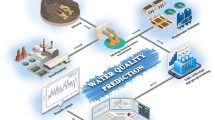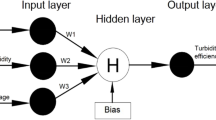Abstract
Predicting the flocculant dosage in the drinking water treatment process is essential for public health. However, due to the complexity of water quality and flocculation, many difficulties remain. The present study aimed to report on using artificial intelligence, namely, the Elman neural network (ENN), to predict the flocculant dosage and explore the applications of the proposed model in waterworks. The flocculation process of drinking water was introduced in this study, and four typical models were developed based on multiple linear regression (MLR), the radial basis function neural network (RBFNN), the least squares support vector machine (LSSVM), and the ENN. To improve the prediction accuracy, a mixed term including long-term data and short-term data was proposed to capture the periodic and time-varying characteristics of water quality data. The weights of each part are updated adaptively according to the comparison of effluent turbidity and set values. The results demonstrate that the proposed ENN model performed better than the other three models in terms of the prediction performance. With the ENN model of flocculant dosage, the root mean square error (RMSE), mean absolute percentage error (MAPE), and coefficient of determination (R2) of the test data were 1.8917, 5.0067, and 0.8999, which were improved by 36.9%, 41.5%, and 14.0% in comparison with the best one (RBFNN) of the other three models, respectively. The effluent turbidity of sedimentation tank was more stable under the control of proposed ENN model of flocculant dosage than the other three models. Considering its performance, the ENN model can be taken as a preferred data intelligence tool for predicting the drinking water flocculant dosage.







Similar content being viewed by others
Data availability
The datasets obtained and analyzed in the current study are available from the corresponding author on reasonable request.
References
Behera SK, Kalyani G, Amrita B, Park HS (2016) Response surface optimization of pH and coagulant dosage for pharmaceutical wastewater pretreatment using alum and bentonite. Desalin Water Treat 57:6863–6874
Bertone E, Stewart RA, Zhang H, O'Halloran K (2016) Hybrid water treatment cost prediction model for raw water intake optimization. Environ Modell Softw 75:230–242
Bivins A, Greaves J, Fischer R, Yinda KC, Ahmed W, Kitajima M, Munster VJ, Bibby K (2020) Persistence of SARS-CoV-2 in Water and Wastewater. Environ Sci Technol Lett 7:937–942
Chawakitchareon P, Boonnao N, Charutragulchai P (2017) Prediction of Alum Dosage in Water Supply by WEKA Data Mining Software. Front Artif Intel Ap 292:83–93
Chew CM, Aroua MK, Hussain MA (2017) A practical hybrid modelling approach for the prediction of potential fouling parameters in ultrafiltration membrane water treatment plant. J Ind Eng Chem 45:145–155
Feng R, Zheng HJ, Gao H, Zhang AR, Huang C, Zhang JX, Luo K, Fan JR (2019) Recurrent Neural Network and random forest for analysis and accurate forecast of atmospheric pollutants: A case study in Hangzhou, China. J Clean Prod 231:1005–1015
Gaballah MS, Ismail K, Aboagye D, Ismail MM, Sobhi M, Stefanakis AI (2021) Effect of design and operational parameters on nutrients and heavy metal removal in pilot floating treatment wetlands with Eichhornia Crassipes treating polluted lake water. Environ Sci Pollut R
Gani P, Sunar NM, Matias-Peralta H, Latiff AA (2017) Effect of pH and alum dosage on the efficiency of microalgae harvesting via flocculation technique. Int J Green Energy 14:395–399
Gholami M, Ghaneian MT, Fatemi SS, Talebi P, Dalvand A (2020) Investigating the efficiency of coagulation and flocculation process in wastewater treatment of paper and cardboard recycling industry. Int J Environ an Ch
Guo T, He W, Jiang ZL, Chu XM, Malekian R, Li ZX (2019) An Improved LSSVM Model for Intelligent Prediction of the Daily Water Level. Energies 12
Hu Z, Zhang SM, Lou JJ (2013) Implementation of Fuzzy Adaptive PID in Thickener Flocculation Dosing Control System based on Properties of Mining Materials. Adv Mater Res-Switz 738:307
Huang CP, Liu CB (1996) Automatic control for chemical dosing in laboratory-scale coagulation process by using an optical monitor. Water Res 30:1924–1929
Kargoll B, Omidalizarandi M, Loth I, Paffenholz JA, Alkhatib H (2018) An iteratively reweighted least-squares approach to adaptive robust adjustment of parameters in linear regression models with autoregressive and t-distributed deviations. J Geodesy 92:271–297
Khemet B, Richman R (2018) A univariate and multiple linear regression analysis on a national fan (de) Pressurization testing database to predict airtightness in houses. Build Environ 146:88–97
Klarich KL, Pflug NC, DeWald EM, Hladik ML, Kolpin DW, Cwiertny DM, LeFevre GH (2017) Occurrence of Neonicotinoid Insecticides in Finished Drinking Water and Fate during Drinking Water Treatment. Environ Sci Technol Lett 4:168–173
Le OTH, Tran LN, Doan VT, Pham QV, Ngo AV, Nguyen HH (2020) Mucilage Extracted from Dragon Fruit Peel (Hylocereus undatus) as Flocculant for Treatment of Dye Wastewater by Coagulation and Flocculation Process. Int J Polym Sci:1–9
Li CM, Zhu L, He ZY, Gao HM, Yang Y, Yao D, Qu XY (2019) Runoff Prediction Method Based on Adaptive Elman Neural Network. Water-Sui:11
Li LX, Piao YJ, Ma F, Sheng T, Sun CY, Liu WM (2020a) Preparation of a novel inorganic-biological composite flocculant for the removal of turbidity and organic matter in the surface water. Desalin Water Treat 180:219–226
Li Y, Zhou SL, Liu K, Wang GM, Wang JX (2020b) Application of APCA-MLR receptor model for source apportionment of char and soot in sediments. Sci Total Environ 746
Li YY, Zhang H, Wang XY, Ma J, Lian LL, Lou DW (2020c) Preparation and Flocculation Performance of Polysilicate Aluminum-Cationic Starch Composite Flocculant. Water Air Soil Poll 231
Maier HR, Morgan N, Chow CWK (2004) Use of artificial neural networks for predicting optimal alum doses and treated water quality parameters. Environ Modell Softw 19:485–494
Nia HM, Sarvi MN, Bagherpour R (2020) Development of a kinetical investigation method using adsorption kinetic models for selection and optimization of flocculation process. Sep Sci Technol
Pena-Guzman C, Melgarejo J, Prats D (2016) Forecasting Water Demand in Residential, Commercial, and Industrial Zones in Bogota, Colombia, Using Least-Squares Support Vector Machines. Math Probl Eng 2016
Rahimi M, Abdollahzadeh AA, Rezai B (2015) The Effect of Particle Size, pH, and Flocculant Dosage on the Gel Point, Effective Solid Stress, and Thickener Performance of a Coal-Washing Plant. Int J Coal Prep Util 35:125–142
Rozario APR, Devarajan N (2020) Monitoring the quality of water in shrimp ponds and forecasting of dissolved oxygen using Fuzzy C means clustering based radial basis function neural networks. J Amb Intel Hum Comp
Sakhi D, Elmchaouri A, Rakhila Y, Abouri M, Souabi S, Hamdani M, Jada A (2020) Optimization of the treatment of a real textile wastewater by coagulation-flocculation processes using central composite design. Desalin Water Treat 196:33–40
Sangu Y, Yokoi H, Tadokoro H, Tachi T (2015) Verification of automatic coagulant dosage control technology based on aluminum concentration at a water purification plant. Water Sci Tech-W Sup 15:26–33
Scalize PS, Souza LMD, Albuquerque A (2019) Reuse of Alum Sludge for Reducing Flocculant Addition in Water Treatment Plants. Environ Prot Eng 45
Selvi S, Chandrasekaran M (2020) Framework to forecast environment changes by optimized predictive modelling based on rough set and Elman neural network. Soft Comput 24:10467–10480
Shandany SMH, Taghvaeian S, Maestre JM, Firoozfar AR (2019) Developing a centralized automatic control system to increase flexibility of water delivery within predictable and unpredictable irrigation water demands. Comput Electron Agr:163
Singh NK, Singh AK, Tripathy M (2015) Short-Term Load/Price Forecasting in Deregulated Electric Environment using ELMAN Neural Network. 2015 International Conference on Energy Economics and Environment (Iceee)
Soleymani SA, Goudarzi S, Anisi MH, Hassan WH, Idris MYI, Shamshirband S, Noor NM, Ahmedy I (2016) A Novel Method to Water Level Prediction using RBF and FFA. Water Resour Manag 30:3265–3283
Stefanescu M, Cosma C, Cristea I, Nitoi I, Bumbac C, Badescu V (2015) Drinking Water Treatment with Recovered Flocculant from Alumina Fabrication Process. J Environ Prot Ecol 16:1509–1514
Su Z, Yu W, Liu T, Li X, Graham NJD, Lu Y, Wiesner MR (2021) Discovery of Welcome Biopolymers in Surface Water: Improvements in Drinking Water Production. Environmental Science & Technology 55:2076–2086
Sun GP, Jiang P, Xu H, Yu SE, Guo D, Lin G, Wu H (2019) Outlier Detection and Correction for Monitoring Data of Water Quality Based on Improved VMD and LSSVM. Complexity 2019:1–12
Tang XM, Huang T, Zhang SX, Zheng J, Zheng HL (2020) Synthesis of an amphoteric chitosan-based flocculant and its flocculation performance in the treatment of dissolved organic matter from drinking water. Desalin Water Treat 174:171–177
Wang HF, Hu H, Wang HJ, Zeng RJ (2018a) Impact of dosing order of the coagulant and flocculant on sludge dewatering performance during the conditioning process. Sci Total Environ 643:1065–1073
Wang JG, Lv Z, Liang Y, Deng LJ, Li ZW (2019) Fouling resistance prediction based on GA-Elman neural network for circulating cooling water with electromagnetic anti-fouling treatment. J Energy Inst 92:1519–1526
Wang KX, Wen X, Hou DB, Tu DZ, Zhu NF, Huang PJ, Zhang GX, Zhang HJ (2018b) Application of Least-Squares Support Vector Machines for Quantitative Evaluation of Known Contaminant in Water Distribution System Using Online Water Quality Parameters. Sensors-Basel 18
Wu YM, Wu DH, Li DD (2020) Fuzzy RBF Neural Network PID Controller for Drum Water Level System of Waste Microbial Biomass Boiler. Acta Microsc 29:2848–2855
Xia X, Lan SH, Li XD, Xie YF, Liang YJ, Yan PH, Chen ZY, Xing YX (2018) Characterization and coagulation-flocculation performance of a composite flocculant in high-turbidity drinking water treatment. Chemosphere 206:701–708
Yang JG, Yu SR (2020) Prediction of process parameters of water-assisted injection molding based on inverse radial basis function neural network. Polym Eng Sci 60:3159–3169
Zhang H, Li HF, Yu HR, Cheng SQ (2020) Water quality assessment and pollution source apportionment using multi-statistic and APCS-MLR modeling techniques in Min River Basin, China. Environ Sci Pollut R
Zhang J, Lou YS (2016) Water level prediction based on Improved Grey RBF neural network model. Proceedings of 2016 Ieee Advanced Information Management, Communicates, Electronic and Automation Control Conference (Imcec 2016), 775-779
Zhao Y, Guo L, Liang JB, Zhang M (2016) Seasonal artificial neural network model for water quality prediction via a clustering analysis method in a wastewater treatment plant of China. Desalin Water Treat 57:3452–3465
Acknowledgements
The author wish to thank Suzhou Baiyangwan waterworks for their support in data collection and experiments.
Funding
This work was supported by the National Natural Science Foundation of China (52170001), Science and Technology Project of Water Conservancy of Jiangsu Province (2020056), Major Science and Technology Program for Water Pollution Control and Treatment (2012ZX07403-001) and the NUPTSF (NY220140).
Author information
Authors and Affiliations
Contributions
DSW: supervision, conceptualization, data evaluation, reviewing, and editing writing. XC: conceptualization, investigation, experimental analysis, data evaluation and visualization, writing (original draft), and editing. KWM: reviewing and editing writing. All authors read and approved the final manuscript.
Corresponding authors
Ethics declarations
Ethics approval and consent to participate
Not applicable.
Consent for publication
Not applicable.
Competing interests
The authors declare no competing interests.
Additional information
Responsible Editor: Philippe Garrigues
Publisher’s note
Springer Nature remains neutral with regard to jurisdictional claims in published maps and institutional affiliations.
Supplementary information
ESM 1
Additional file 1: Figure S1. Water quality data acquisition system. Table S1. Raw water quality in January and February in Baiyangwan waterworks during 2015-2019. Table S2. The hourly weight ratio of the different methods. (DOCX 730 kb)
Rights and permissions
About this article
Cite this article
Wang, D., Chang, X. & Ma, K. Predicting flocculant dosage in the drinking water treatment process using Elman neural network. Environ Sci Pollut Res 29, 7014–7024 (2022). https://doi.org/10.1007/s11356-021-16265-4
Received:
Accepted:
Published:
Issue Date:
DOI: https://doi.org/10.1007/s11356-021-16265-4




